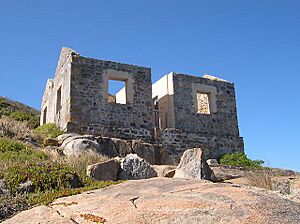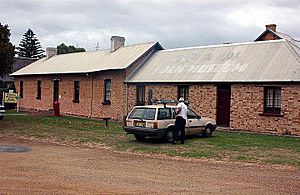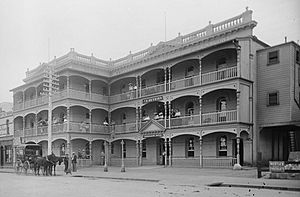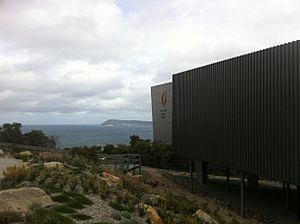History of Albany, Western Australia facts for kids
The coastline near Albany was first seen by Europeans in 1627. A Dutch captain named François Thijssen sailed his ship, 't Gulden Zeepaert (The Golden Seahorse), along the south coast of Australia. He explored about 1,768 kilometres of coastline between Cape Leeuwin and the Nuyts Archipelago.
In 1791, explorer Captain George Vancouver arrived on his ship, HMS Discovery. On September 29, he entered and named King George the Third's Sound and Princess Royal Harbour. He claimed this land for the British Crown. Vancouver worked hard to build good relationships with the local Aboriginal people.
A French explorer, Bruni d'Entrecasteaux, reached Cape Leeuwin in 1792. He explored east along the southern coast but bad weather stopped him from entering King George Sound.
In 1801, Matthew Flinders entered King George Sound. He stayed for about a month before mapping the rest of the southern Australian coast. By 1806, he had sailed all the way around Australia for the first time.
Another French explorer, Nicolas Baudin, visited King George Sound in 1803. He mapped Princess Royal Harbour, Oyster Harbour, and the coast near Bald Island. During his visit, one of his ships, Casuarina, was repaired in Princess Royal Harbour.
Australian-born explorer Phillip Parker King also visited King George Sound in 1822 on his ship Bathurst.
British Settlement in Albany
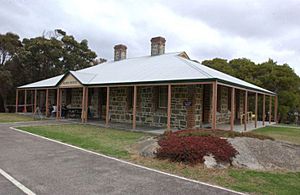
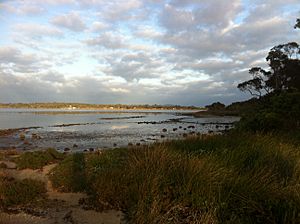
In 1826, the British government decided to set up a settlement at King George's Sound. This was because it was a good location on the shipping route between Britain and Port Jackson (Sydney). Henry Bathurst, a British government official, gave these instructions to Ralph Darling, the Governor of New South Wales.
Major Edmund Lockyer was put in charge of this expedition. He left Sydney on November 9, 1826, on the ship HM brig Amity. He brought twenty soldiers, twenty-three prisoners to help build the settlement, and six months of supplies.
-
-
- Establishing the Settlement
-
Lockyer and his group arrived at King George's Sound on December 25, 1826. The next day, they began surveying the area. On December 30, the soldiers and prisoners came ashore and set up camp. On January 21, 1827, they officially claimed the territory for Britain. This was the first European settlement in Western Australia.
Major Lockyer also helped local Aboriginal women who had been taken by sealers from nearby islands. He caught the sealers and sent them away for trial. Because of this, the local Minang Noongar people held a special ceremony, called a corroboree, to honor him. This helped to build good relationships between the Aboriginal groups and the European explorers.
Lockyer left for Sydney on April 3, 1827. Captain Joseph Wakefield took over command. King George's Sound continued to be a settlement for prisoners for several years.
-
-
- Changes and Naming Albany
-
A new colony, called the Swan River Colony, was started to the north in 1829. This new colony was meant for free settlers, not prisoners. The leaders of the Swan River Colony did not want prisoners in their area. Also, it was expensive and difficult to manage King George's Sound from Sydney.
So, on March 7, 1831, the King George's Sound settlement became part of the Swan River Colony. The prisoners and soldiers were moved back to New South Wales.
The settlement was officially named Albany on January 1, 1832. It was named by Lieutenant-Governor Stirling after The Duke of York and Albany, who was the second son of King George III.
-
-
- Growth and Important Buildings
-
By 1837, Albany had a population of 180 people. There were 45 houses around Princess Royal Harbour.
In 1841, explorer Edward John Eyre reached Albany. He was the first European to travel overland to Western Australia from the eastern colonies.
Construction of St John's Anglican Church began in 1841 and finished in 1844. It was the first church in Western Australia to be officially dedicated.
The Albany Convict Gaol (jail) was built in 1852. It held prisoners who were skilled workers sent to Albany.
The first mayor of Albany was William Finlay, elected in 1885.
The Albany Advertiser newspaper started in 1888. It is still published today and is the oldest newspaper outside of a major city in Western Australia.
-
-
- Protecting the Port
-
During the 1800s, losing control of the port was a worry for Australia. The Princess Royal Fortress was built to protect it. Money for the fortress came from all Australian states, and guns were provided by the British government. This fortress, opened in 1893, was Australia's first major defence project before it even had a federal government.
The Albany Courthouse was built between 1896 and 1898. It was opened by the acting Premier, Edward Wittenoom. The outside of the building still looks much the same today.
Until 1897, Albany had the only deep-water port in Western Australia, Princess Royal Harbour. This is the largest natural harbour on the entire south coast of Australia. Because of this, for many years, mail from England would arrive first at Albany. This gave Albany an important advantage over Perth. This changed when engineer C. Y. O'Connor created the Fremantle Inner Harbour, which became Western Australia's main port.
-
-
- Modern Albany
-
Albany's population grew from 4,500 in 1945 to 10,526 by 1961. Many European migrants moved there during this time.
Today, Albany is a popular place for people to retire. They enjoy the fresh air, clean beaches, and beautiful views of the Southern Ocean. It is also a busy regional centre.
The Albany hospital was rebuilt and opened in 2013. It is now called the Albany Health Campus and cost $170 million. It is the biggest regional hospital project in Western Australia's history.
The Albany Entertainment Centre opened in 2010 as part of new developments near the Albany Port. The National Anzac Centre opened in 2014. It is located near Mount Clarence within the Princess Royal Fortress Military Museum area.
Albany's Role in World War I
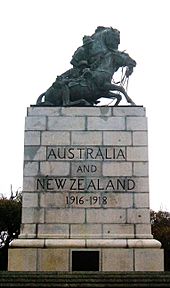
In late October 1914, ships carrying Australian and New Zealand soldiers gathered at Albany. These soldiers were part of the Australian Imperial Force and the New Zealand Expeditionary Force, later known as ANZACs. They were heading to Egypt to fight in World War I.
The first group of ships left Albany in a convoy on November 1, 1914. A second group left in late December 1914. Albany was the last place in Australia that these ANZACs saw. The Albany Anzac Peace Park and the Pier of Remembrance were dedicated in 2010 to remember this important event.
The first fleet of ships included escort vessels like HMS Minotaur from the Royal Navy, the Japanese battlecruiser Ibuki, and Australian cruisers HMAS Melbourne and HMAS Sydney. New Zealand warships HMS Pyramus, HMS Psyche, and HMS Philomel were also part of the convoy.
-
-
- Memorials and Commemorations
-
The Desert Mounted Corps Memorial is on top of Mount Clarence. It remembers soldiers from the Australian Light Horse Brigade, the New Zealand Mounted Rifles Brigade, the Imperial Camel Corps, and the Australian Flying Corps who fought from 1916 to 1918. The memorial has a statue of an Australian soldier helping a New Zealand soldier whose horse is hurt. A wall lists the groups remembered.
The first recorded Dawn Service was held by Anglican chaplain Arthur Earnest White on April 25, 1923, on Mount Clarence. This service has been held every year since, with thousands of people attending.
On the nearby Mount Adelaide is the Princess Royal Fortress. It has gun placements, buildings, and a collection of military items. It honours the sacrifice of Australian Defence Force personnel from the Boer War to today.
The contribution of Mustafa Kemal Atatürk, who was president of Turkey, is also remembered. The entrance to Princess Royal Harbour is named Atatürk Entrance, and there is a statue overlooking it.
In 2014, the 100th anniversary of the troops leaving Albany was celebrated. About 40,000 people, including the Australian Prime Minister Tony Abbott and New Zealand Prime Minister John Key, attended ceremonies in the town. This event brought about $30 million into the local economy.
|


